Last Chance to Catch NYC's Holiday Notalgia Train
We met the voices of the NYC subway on our nostalgia ride this weekend!


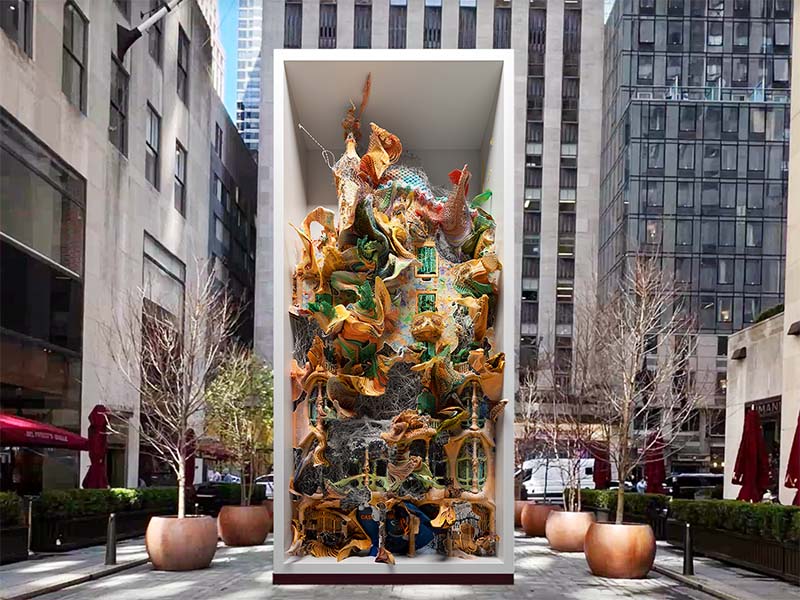
With summer fast approaching, May is the perfect time to head outside and explore the city’s ever-changing public art scene. This May, be sure to check out the virtual bird installation, Bird’s Eye View, at Battery Park City, Yvonne Shortt’s dog sculpture Peppermint, and the AI-generated Midnight Moment’s video Critically Extant. In addition, read on to learn more about art installations still up from previous months.

From May 28 through March 5, 2023, Socrates Sculpture Park will host Steel Bodies, New York-based artist Maren Hassinger’s new sculpture series. Since the early 1970s, Hassinger has explored the relationship between nature and humanity, covering topics such as movement, family, love, nature, environment, and consumerism in her work.
Scattered throughout the park will be various steel sculptures in the forms of iconic vessels drawing types from not only Hassinger’s own artistic practice, but also more broadly from the ancient Western world, non-Western cultures, and craft traditions. Steel Bodies seeks to examine the complications of human interrelation, affinity, identity, and collectiveness through juxtaposing abstract elements to the outdoors.
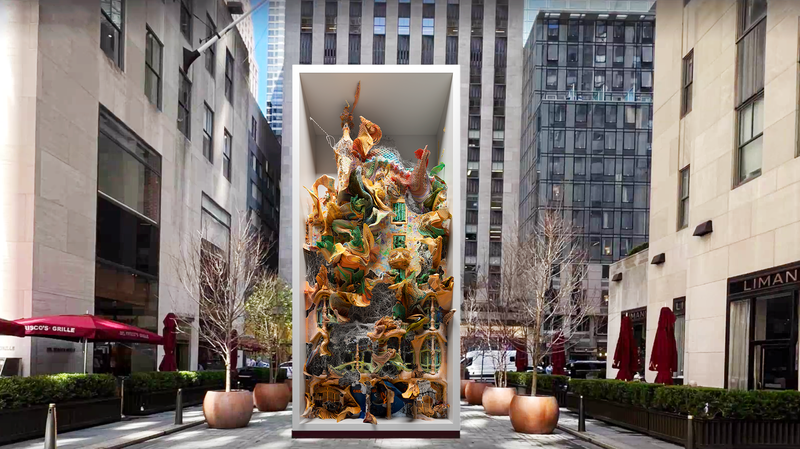
For a limited time, Christie’s will present Casa Batlló: Living Architecture, a monumental artwork inspired by Casa Batlló’s facade in Barcelona, Spain. Created by Turkish-American media artist and director Refik Anadol, Casa Batlló: Living Architecture is the first UNESCO World Heritage Site to take the form of a live NFT, with ephemeris created using climate data from the city collected in real-time being projected onto Casa Batlló’s facade.
The monumental and multisensory experience will remain up outside Rockefeller Plaza through May 13, 2022. On May 10, 2022, Casa Batlló: Living Architecture will be auctioned off as part of the 21st Century Evening Sale and will be the only NFT offered during the five day series of Christie’s Spring Marquees Week sales. Ten percent of the proceeds from the sale will be donated to the Associació Aprenem Autisme and Fundació Adana institutions.
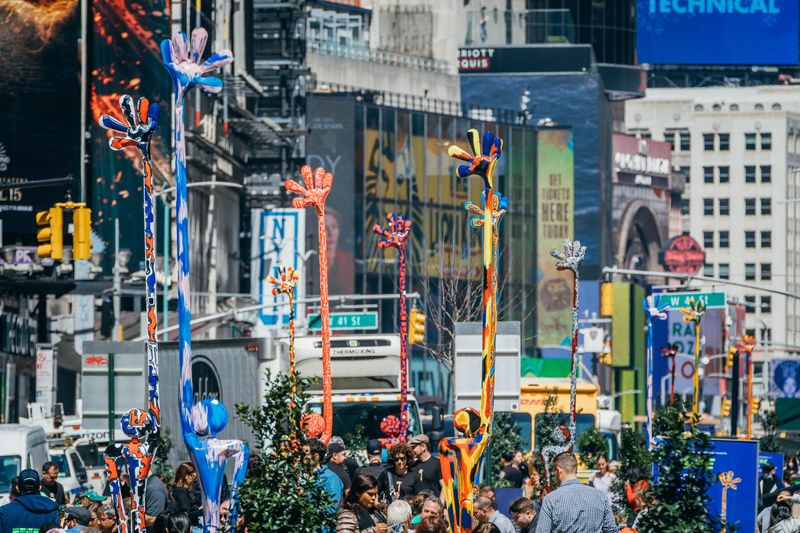
Through August 29, 2022, the Garment District Alliance will present Here, a series of fourteen oversized sculptures with raised hands welcoming residents and visitors to New York City. Created by artist Santi Flores, Here symbolizes the importance of unity, diversity, and individuality while also working to instill hope in its audience as the city looks towards the future.
Crafted from steel, concrete, and enamel paint, Flores’ sculptures vary in size, with the largest towering at 14 feet tall. Each sculpture in Here features the same signature raised hand gesture with different colors and markings on their skin as a representation of New York City’s multicultural community. The sculptures can be found on Broadway between 38th and 41st Streets.
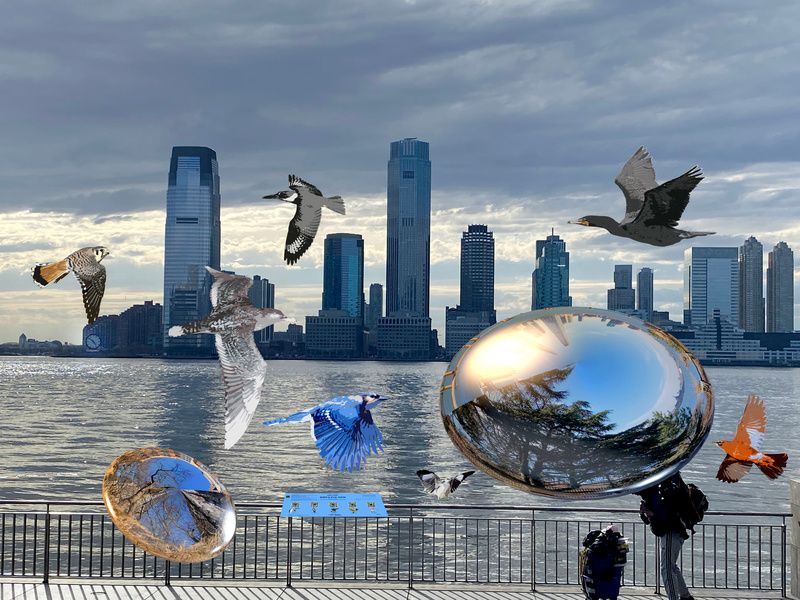
Bird’s Eye View by New York City-based artist Shuli Sadé is a virtual installation featuring photographs and original watercolor images of 30 species of birds that seek temporary or permanent refuge near Manhattan’s waterways through the Adobe Aero app.
Located in Battery Park City are 70 QR codes on 14 signs along the riverfront, which after being scanned with a smartphone camera present images of the birds and information on their migratory patterns. In addition, these signs provide information about the birds and carefully selected lines of poetry intended to draw parallels between the repetitive nature of bird sounds and the word’s syllables. The installation was inspired by the flight patterns of birds above the Hudson River and along Battery Park City’s gardens, working to bring more awareness to the environment in urban settings. Bird’s Eye View will be on display until November 2022.
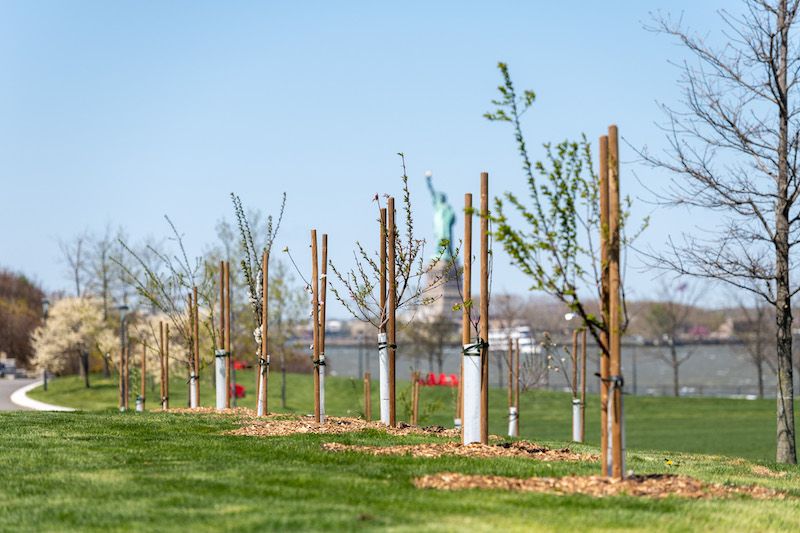
This spring, Sam Van Aken’s installation The Open Orchard will be on display at Governors Island. Taking the form of a public orchard with 102 fruit trees, The Open Orchard acts as a living archive for antique and heirloom fruit varieties that have been grown in the New York area over the last 400 years but have mostly disappeared due to climate change and industrialization. To preserve these rare fruit species, Van Aken has utilized a unique grafting process in which multiple fruit varieties are combined into a single tree, allowing them to grow alongside one another. In doing so, the fruits are able to grow in a safer environment.
As part of Van Aken’s project, 100 additional trees will be donated and planted in community gardens throughout the five boroughs in partnership with NYC Parks GreenThumb. Accompanying the art installation will also be a workshop series, talks and performances, fruit tastings, harvest events, and culinary lessons.

Through May 8, 2022, Creative Time will present Jill Magid’s Tender Presence, a live film and sound installation that serves as an extension of Magid’s 2020 public art project, Tender. In this project, Magid distributed 120,000 modified U.S. pennies engraved with the phrase “The Body Was Already So Fragile” into the economy—amounting to the equivalent of one single $1,200 COVID stimulus check. Two years later, Tender Presence picks up where Tender left off, reflecting on the impact of the pandemic and the new society it has resulted in with an emphasis on life’s inherent fragility and the interdependence of social, financial, and biological health.
Tender Presence is located within the neoclassical historic Dime Savings Bank of Williamsburg, a building symbolic of the 19th-century savings bank movement where low-income earners could open an account for just one dime—though the bank remains vacant today. As visitors enter the bank and explore its cavernous interior, live music greets them. Afterward, a short film featuring footage taken during lockdown in 2020, including in the bank’s surrounding neighborhood, is played. Juxtaposing scenes depicting the pandemic’s early influence is the theme of our society’s ever-changing economic landscape.

BIRDLINK is a scale-able replicable network of living habitat sculptures filled with meadows of native plants. These sculptures work to support migratory birds and the seeds they disperse, which help to maintain and expand the city’s ecosystem. Rather than simply being viewed as a symbol of the bird’s lost natural habitat, BIRDLINK inspires their recovery and alerts viewers to the challenges facing the world’s bird populations. In addition, the sculpture’s signage and online links aid the sculptures in serving as community gathering places for educators to research and teach about the city’s birds.
Past iterations of BIRDLINK have been located at Sara D. Roosevelt Park, Marsha P. Johnson Park, and Governors Island. Currently, BIRDLINK is on display at Crotona Park in the Bronx through May 21, 2022. The next iteration of BIRDLINK is scheduled to include three prototypes varying in size, configuration, and planting palettes with a new location soon to be announced in conjunction with the New York City and State Department of Parks and Recreation.
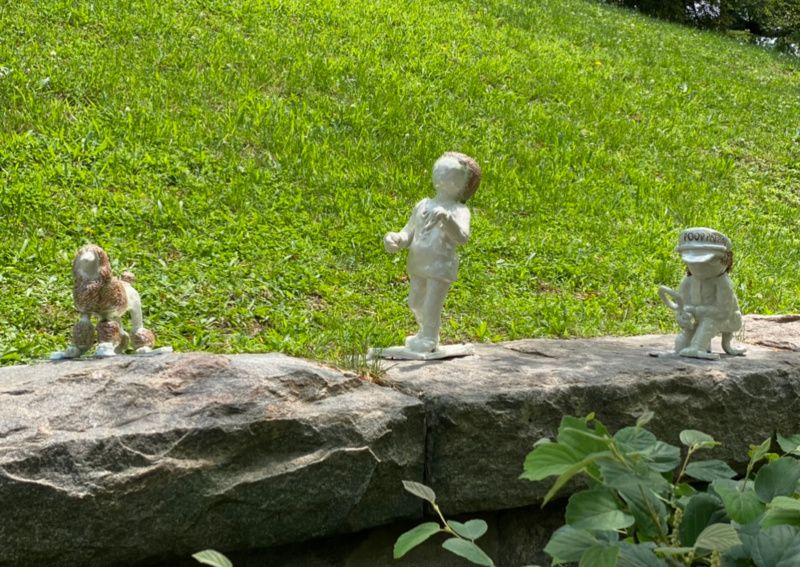
Located in Forest Park is Peppermint, a whimsical sculpture inspired by the ever-present New York City dog poop pickup situation. To display this predicament, Peppermint features a sharply dressed woman in heels holding a leash, a dog, and a person wearing a poop patrol hat on their knees utilizing a magnifying glass to examine the ground below them.
Peppermint was created by Yvonne Shortt, a visually impaired African American social practice installation artist whose work deals with the themes of disability, equality, community, and race. Shortt was inspired to create the sculpture by her adventures in Forest Park’s dog run with her Airedale terrier Peppermint. The sculpture intends to remind New Yorkers to clean up after their dogs and will be on display until June 11, 2022.

On May 7, Green-Wood Cemetery will begin presenting Heidi Lau’s Gardens as Cosmic Terrains, a sculpture installation located in the catacombs. As Green-Wood Cemetery’s first-ever artist in residence, Lau was selected from more than 1,000 other candidates and currently resides in the cemetery’s Fort Hamilton Gatehouse.
Gardens as Cosmic Terrains features ceramic sculptures hanging from the catacomb’s skylights, drawing inspiration from funerary items such as urns, bells, and spirit vessels. Sculpture designs also draw heavily from the structure of traditional Chinese gardens and the themes of nostalgia, memory, Taoist practices, and the history of Macau, where Lau spent her early years. The installation will be open to the public on Saturdays and Sundays from 11 a.m. to 5 p.m. until July 3, 2022.

During the month of May, Times Square Arts will present Sofia Crespo’s Critically Extant as part of the Midnight Moment series. Presented in collaboration with Meta Open Arts and Meta Al Research, Critically Extant explores the limits of our knowledge about the natural world by testing the openly available data that resides on digital platforms. After training artificial intelligence algorithms using millions of open-source images of nature—including ten thousand animal and plant species—these models were utilized to generate visual representations of critically endangered species that typically receive little media coverage.
In doing so, Critically Extant works to bring awareness to the impending extinction of some of the Earth’s most vital creatures. Moreover, as a result of missing or skewed data, many of the AI-generated creatures bear little resemblance to their real-life counterparts, adding an element of mystery and intrigue to the video. At the same time, just as Critically Extant acknowledges the gaps in our understanding, it also explores how digital feedback loops can be harnessed to produce positive outcomes in the natural world. To do so, alongside the video, Crespo has also created a series of AR filters inspired by critically-endangered animal and plant species native to New York state—helping to frame these species in the context of everyday life.
“In the same way we can’t imagine a color we’ve never seen before, a neural network can’t image something from data it didn’t receive. The creatures in this exhibition are a reflection of our collective knowledge of the natural world, which is very limited,” Crespo said.
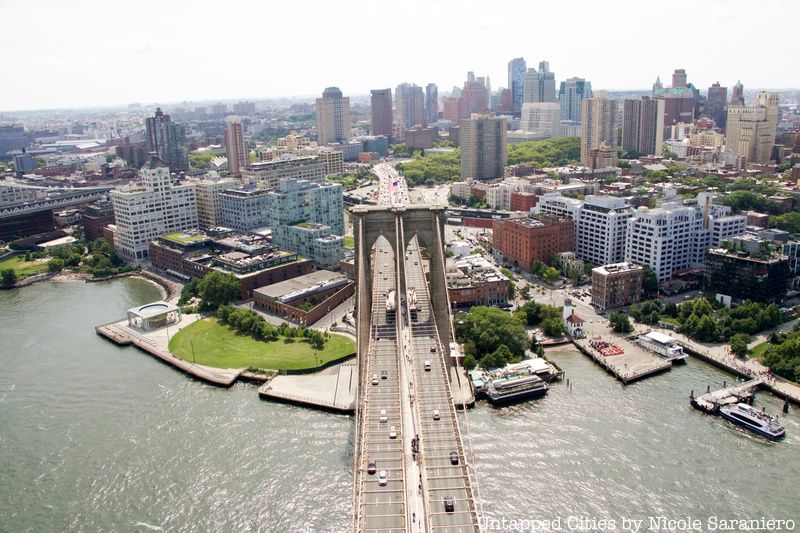
On May 17, artist Hugh Hayden and Public Art Fund Curator Daniel S. Palmer’s exhibition Black Atlantic will open at Brooklyn Bridge Park. Named after Paul Gilroy’s novel of the same name, Black Atlantic was created to highlight the complex hybrid identities that have developed as a result of the exchange of culture and ideas along transatlantic networks linking Africa, Europe, the Caribbean, and the United States.
The exhibition will also feature the work of Leilah Babiyre, Hugh Hayden, Dozie Kanu, Tau Lewis, and Kiyan Lewis—five artists who share a commitment to material exploration, fusing contemporary ideas with the historical, and exploring processes of making and fabrication by hand. Through the artwork featured in Black Atlantic, the exhibition will challenge its audience to embrace a more open, multifaceted, and heterogeneous idea of Black identity in the United States. Black Atlantic will be on view through November 2022.
Continue reading to see what is still on display from previous months in NYC!
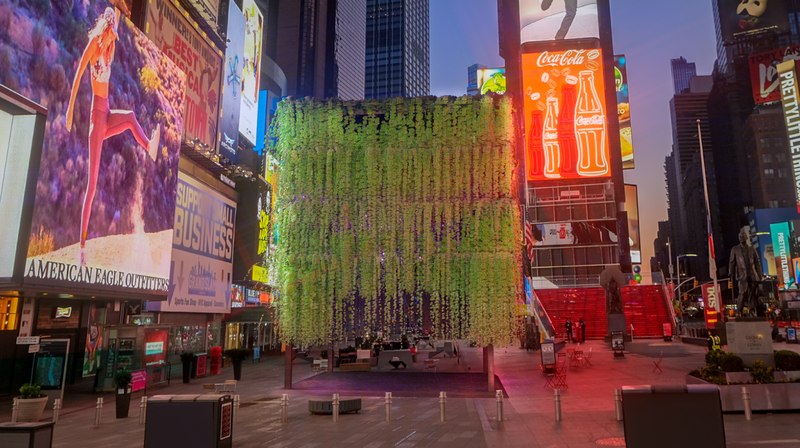
Opening this spring is THE POEM, an immersive public art installation by Cuban artist Raul Cordero presented through Times Square Arts. THE POEM is a large-scale sculptural tower featuring an illuminated text interior juxtaposed by a landscaped exterior of cascading mountain laurel foliage designed by Canal Gardens Inc. Standing inside the 20-foot sculpture, the viewer’s only line of vision becomes the open sky and a haiku written by poet Barry Schwabsky in black light. Serving as a continuation of Cordero’s extensive use of text and abstract imagery in his work, the sculpture is presented as a commentary on the distracting nature of modern life where technological advancements have increased access to information while inadvertently decreasing attention spans. THE POEM will be on display from April 8 to May 4, 2022.
“It’s difficult to create meaningful art for people in an era when their attention is scattered across so many mediums and technologies simultaneously,” Cordero said. “THE POEM seeks to stop time, reminding us that humans also have the capacity to invest in one thing at a time — like listen to “the secret dialogue of trees” (as put poetically by Reinaldo Arenas) and read a haiku, even when standing in the center of Times Square.”

Through May 6, 2022, the Paula Cooper Gallery will present Plantoir, Blue, a large-scale sculpture of a blue gardening tool. Plantoir, Blue was created by the husband-wife team Claes Oldenburg and Coosje van Bruggen, who have become famous for their large-scale sculptures of everyday objects. Through their artwork, Oldenburg and Coosje celebrate the beauty of everyday life, taking familiar items such as a toy box or fruit bowl and transforming them into enlarged figures fixed in moments of energetic motion.
At 23 feet tall, Plantoir, Blue stands upright with its point submerged in the ground as if it had fallen into place from the sky. The sculpture will be located at the Fifth Avenue entrance to the Channel Gardens at Rockefeller Center.

Through July 31, 2022, international artists and conservationists Gillie and Marc Schattner will present
Faces of the Wildas part of their #LoveTheLast series. At the moment, over 32,000 species listed on the IUCN are threatened by extinction with habitat loss, poaching, pollution, and climate change being the biggest threats to these creatures. Just as we love and care for our friends and family, Faces of the Wild seeks to inspire a love for wildlife in the face of the world’s slowly dissipating biodiversity.
Located in Greenwich Village’s Ruth Wittenberg Triangle, Faces of the Wild features nine six-foot-tall sculptures representing some of the world’s most endangered animals. These animals include the northern white rhino, chimpanzee, addax, western lowland gorilla, polar bear, red wolf, African forest elephant, hippopotamus, and lion. In addition, accompanying each sculpture is a QR code with information on conservation and an option to donate to Gillie and Marc’s partner charity World Wildlife Fund.
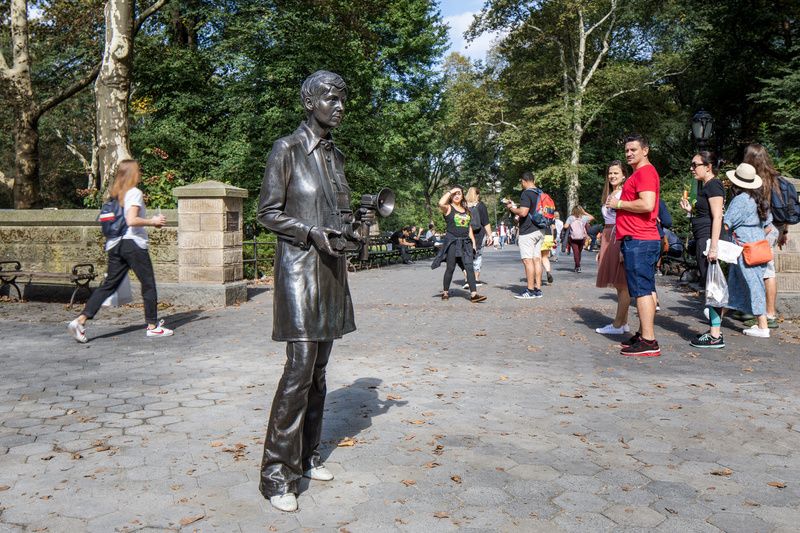
Located at the Doris C. Freedman Plaza at Fifth Avenue and 60th Street is a five feet, six-inch bronze sculpture of photographer Diane Arbus by artist Gillian Wearing. Arbus has long been a source of inspiration for Wearing, who in 2008 created a photo entitled “Me as Arbus,” paying homage to the photographer by recreating an iconic portrait of Arbus. Presented by the Public Art Fund, the sculpture features Arbus standing with her camera pointed toward the ongoing crowd and her finger on the shutter button. Through creating the sculpture at eye level, Wearing hopes to highlight the “human approach” Arbus took to the art of photography. The sculpture will be on display until August 14, 2022.
As Nicholas Baume, the Public Art Fund’s artistic and executive director stated, “In [Gillian Wearing’s] bronze ‘Diane Arbus,’ we see the posthumous homage to a pioneering artist by another from a different time and place. We also see a modest, unassuming figure, standing at the entrance to Central Park, recognizable by the most distinctive attribute of her public self: her Rolleiflex camera.”

In collaboration with the United Nations Environment Programme and the Climate Museum, Rockefeller Center will present the third annual The Flag Project. Each year, art created by the public is placed on display on one of the 193 flagpoles that surround the Plaza. For 2022, submissions include mixed-medium artwork celebrating “Only One Earth,” with the winning designs being transformed into eco-friendly biodegradable flags.
Past artists featured in The Flag Project include Jeff Koons, KAWS, Marina Abramovich, and Ryan McGinley. In honor of Earth Day, these flags will be flown over Rockefeller Center through May 6, 2022. They will also be flown again on June 5th for World Environment Day.

Throughout New York City, Chicago, and Boston, the Public Art Fund will showcase the work of 20 intergenerational artists from 17 different countries on 320 JCDecaux bus shelters, illustrating how they have processed our turbulent times through humor, incisiveness, and hope. With artists from six continents including the Amazon rainforest in Columbia, the port city of Accra, Ghana, and Yangon, Myanmar, Global Positioning allows viewers to connect with the world beyond the United States.
Each work presented in the series reflects upon the meaning of individual existence, cultural identity, and interconnectedness, with a heightened awareness of the growing impact of climate change. Several pieces also tackle the relationship between Indigenous forms of knowledge and the popular culture of the modern world. Global Positioning will remain up through June 5, 2022.

Located outside Google’s new campus at St. John’s Terminal in Hudson Square is the mural Moonfolk: Passages Toward Greater Understanding. Created by multimedia artist Tomashi Jackson, Moonfolk: Passages Toward Greater Understanding’s design is meant to evoke the possibility of outpourings of radiant and peace-filled communication. In addition, the mural aims to provoke discourse, pertaining to the acquisition of peace for and by children.
Accompanying the mural are artistic responses to Tomashi’s work created by New York City youth ages 3-12. Presented in partnership with the Children’s Museum of the Arts (CMA) and ArtBridge, Moonfolk: Passages Toward Greater Understanding highlights CMA’s commitment to inspiring global conversations and fostering ties between the children of New York and the wider artistic community. The mural will be on display through June 1, 2022.

At 6th Avenue and West 47th Street New York-based sculptor Jim Rennert will present three larger-than-life sculptures through 2023 that depict the daily struggles and achievements of everyday people. Embodying the fast-paced New York City lifestyle, these sculptures represent the meeting point between the business world and ordinary life.
The first sculpture in the series, Timing, depicts a person looking anxiously at their watch, highlighting the importance of timing, being in the right place at the right time, and the difficulty we all face to find balance in our schedules. Inner Dialogue in comparison involves a small figure standing in the palm of a figure, metaphorically showcasing the familiar feeling of having a conversation with one’s conscience. To round out the sculptures, Commute features a figure sitting on a bench with a briefcase in his hand as he waits for the train — honoring the work Americans perform every day in less bucolic settings with minimal physical engagement.

Along Park Avenue between 34th and 38th Streets in the Murray Hill neighborhood are a series of polygonal-shaped animal sculptures by artist Idriss B. Born and raised in Paris, Idriss B. has previously helped create retail and window displays for luxury brands such as Dior, Coach, and Michael Kors. Presented by Patrons of Park Avenue (POPA), these sculptures serve as the organization’s inaugural art installation. Featured sculptures include Rexor the Tyrannosaurus Rex, Mojo the Gorilla, Baloo the Bear, and Manny the Mammoth, among others. Exhibited as part of NYC Parks’ Art in the Parks Program, Idriss B’s work will be on display until February 2023.
“One of the most beautiful places in the world is New York and it is the perfect place for me to exhibit my work,” Idriss B. said. “It is a hardworking city with a warm family environment, so it is very fitting for people to see and feel the strength of my pieces while bringing the fun to everybody, especially the kids.”

On your visit to Forest Hills this summer, an exciting new artwork to check out is Afro Pick: Remembering & Moving Forward. Surrounded by a beautiful array of Versicolor wildflowers in MacDonald Park, Yvonne Shortt’s larger-than-life afro pick sculpture draws inspiration from the item’s storied history. Originating over 5,500 years ago in Egypt, afro picks were once made from wood or stone and were used to tell narratives of the cultures or tribes carving them. Unrecognizable today from their ancient counterparts, afro picks are now largely fabricated using plastic. Since the 1970s, afro picks have become important symbols of Black power, readily used throughout the ‘Black is Beautiful’ movement. This movement sought to promote an embrace of Black culture and identity, with one crucial element being the adoption of more natural and less Westernized hairstyles. As an ode to this, Afro Pick: Remembering and Moving Forward honors those who have died during the pandemic in Shortt’s community (the artist lost both of her grandmothers). Made from recycled wood, the pick’s handle tells a story of strength and resilience, inscribed with the words: “The Iris versicolor wildflower symbolizes wisdom, faith, and courage. Hopefully, we have gained wisdom through COVID, faith from our community and houses of worship, and the courage to envision a better place for our children.”
Situated at the top of the handle is a bust of a young girl, whose features were drawn from several individuals of different cultural backgrounds living within Shortt’s community. As a symbol of diversity and hope for the future, the girl also serves as a representation of the African American community’s perseverance over time. This is exemplified in her hair texture, which is inspired by African rice braiding, a technique used by enslaved people to prevent hunger during their journeys on the Middle Passage. At the bottom of the statue is a series of metal rods that serve as the teeth of the afro pick, reflecting the move from wooden to metal teeth during the 1950s and 1960s. Six additional afro picks will be installed at Queens College and two at Marymount Manhattan College. In September, three other picks will also be placed at Socrates Sculpture Park as part of Shortt’s Hair Sanctuary sculpture.
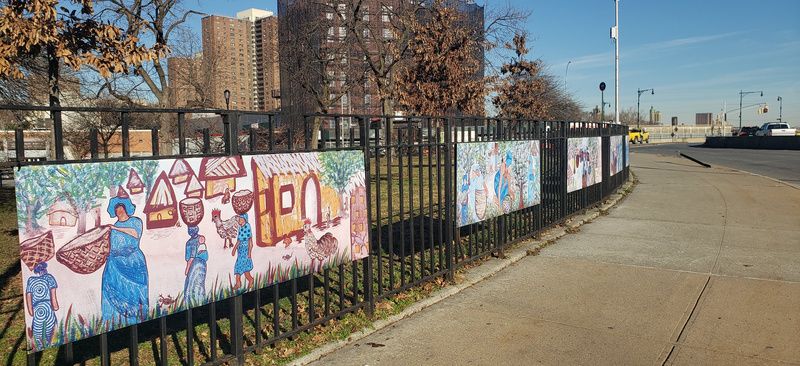
On display in Manhattan’s Colonel Charles Young Triangle Park is Iya Alaro by Oluwaseyi (Shayee) Awoyomi, a fifth-generation textile dryer from the Yoruba people of Nigeria. Presented by Harlem Needle Arts, the installation is part of Indigenous Threads, a public art series representing the origins of traditional African textiles. It tells the story of Iya Alaro — known as the “Mother of Dyes.”
Tasked with great responsibility, Iya Alaro oversees the harvesting of the indigo plant, known as Adire. In Yoruba this translates as (adi) “to tie” and (re) “to dye.” Alaro is tasked with preparing the dye baths, creating the composition of solvents, and organizing the community of women collecting the plant. After the Adire has been prepared for the market, the Iyaloja (“Mother of the Market”) is voted for by the fellow market women, nominated by the king, or politically chosen. To capture this story, the installation features sketches of Iya Alaro and women dressed in indigo harvesting the plant. Iya Alaro will remain up until December 15, 2022.

Stand-Speak-Shape is a large-scale crochet mural by the Chinatown Yarn Circle Project in collaboration with Think Chinatown, the Creative Sanctum, and artist Naomi Lawrence. On display until October 8, 2022, the mural ushers in words of strength, synergy, and solidarity to culturally inspire Chinatown residents to stand strong together, speak up for justice, and shape society through sharing community life together. In addition, the mural serves as a tribute to AAPI community builders and a means of bringing awareness to issues facing members of the community.
Featuring nearly 1,000 crochet squares, over 1,000 leaves, and 1,500 flowers sewn together into a 4-foot-high by 25-foot-wide mural, Stand-Speak-Shape adorns the fences of Columbus Park. Crocheted by neighborhood volunteers, the mural’s flowers serve as symbolic ties to the Asian community at large. Example flowers in the mural include Plum Blossoms for Taiwan, Chrysanthemum for Japan, Arabian Jasmine for the Philippines, and Hibiscus for Malaysia among others.
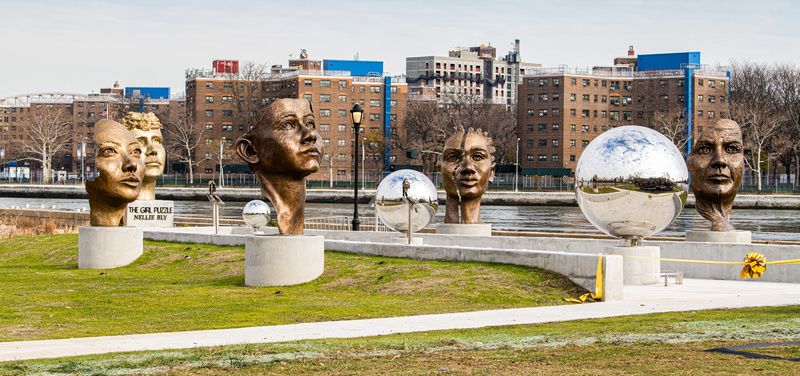
Located on Roosevelt Island is The Girl Puzzle, a monument installation by artist Amanda Matthews paying tribute to Nellie Bly. Over the course of her life, Bly worked as a journalist, women’s rights activist, suffragist, World War II correspondent, inventor/patent holder, industrialist, and humanitarian. Above all else, she strived to write stories exposing the struggles of marginalized individuals like herself and pushed for equality and progress, especially for women. In particular, The Girl Puzzle was inspired by Bly’s 1885 response to bigotry and her 1887 seminal work, Ten Days in a Mad-House, in which she exposed the deplorable living conditions she witnessed at the Blackwell Island Asylum on Roosevelt Island, which she gained access to by feigning insanity.
To highlight Bly’s legacy, The Girl Puzzle presents the faces of other women who have endured hardship in their lives and were made stronger because of it. In the center of the monument is a bust of Bly’s face cast in silver bronze and three silver globes representing her journalism career. Surrounding Bly’s face and the silver globes are four additional busts cast in bronze representing Asian American, Black, young, older, and queer women, each rendered in partial sections to appear like giant puzzle pieces. The faces express the deep emotion of being both broken and repaired and allow the audience to interact with the reflective surfaces and imagine the different parts of the face coming together. In addition, Bly’s words are engraved behind each woman, representing the spirit and complexity of women and the stories they have to tell.

Located at Flushing Meadows-Corona Park in the David Dinkins Circle is Going Back to the Meadows, A Tribute to LL Cool J and Performance at F.M.C.P — also labeled as The G.O.A.T. Monument — a statue honoring American rapper LL Cool J. Support for the statue was provided through the NYC Art in the Parks: Alliance for FMCP Grant, Queens Council on the Arts, and City Artist Corps Grant.
Created by artist Sherwin Banfield, The G.O.A.T. Monument features a representation of a younger LL Cool J wearing a Kangol hat and holding a gold boombox. Sitting inside the box is a cassette of “Radio,” the musician’s first record. The statue comes on the heels of LL Cool J’s induction into the Rock & Roll Hall of Fame, which took place on October 30, 2021. Going Back to the Meadows, A Tribute to LL Cool J and Performance at F.M.C.P will be on display until November 2022.
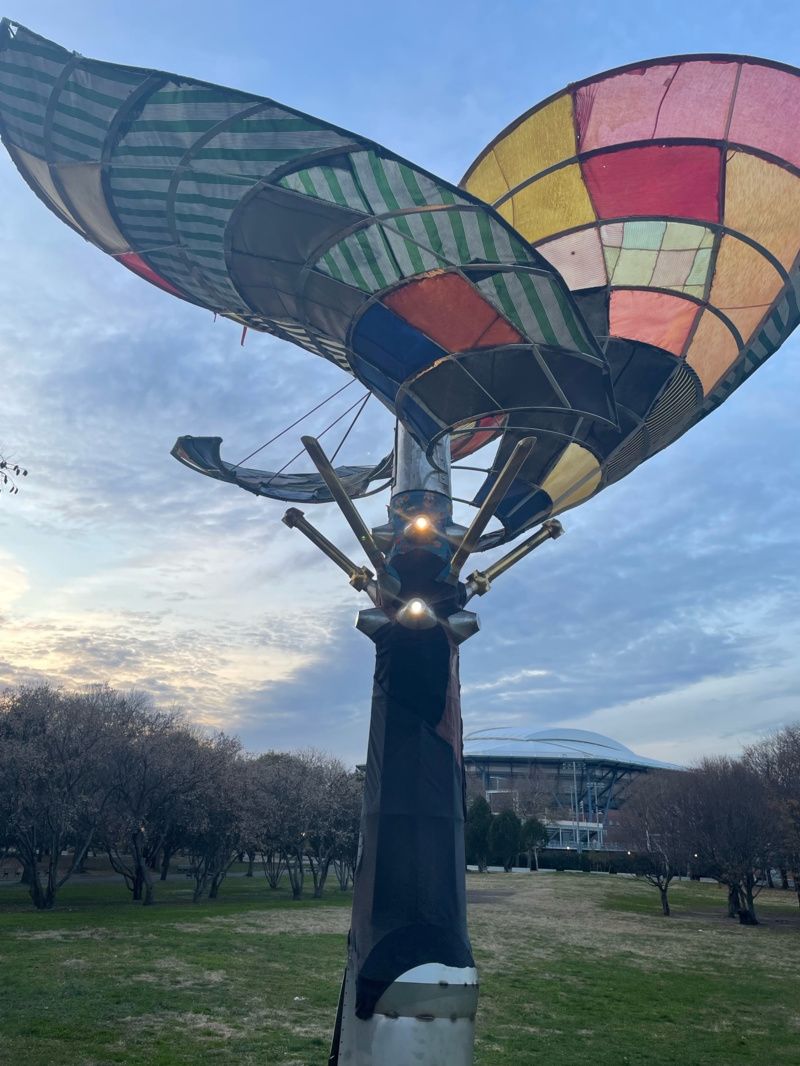
Through November 23, 2022, Haksul Lee’s sculpture, The Giving Tree will be on display in Flushing Meadows-Corona Park. The sculpture works to bring awareness to the environmental concerns of the Queens community. It was created thanks to support from the Art in the Parks: Alliance for Flushing Meadows Corona Park Grant, which provides funding for site-specific public art installations in two locations at the park.
Using wind power to generate electricity, the artificial tree will light the park and provide a charger station for visitors. In addition, The Giving Tree serves as a form of altruism promoting a higher level of collective consciousness to push New Yorkers towards acknowledging and addressing the climate issues that currently affect the city and issues that stand to arise in the future.
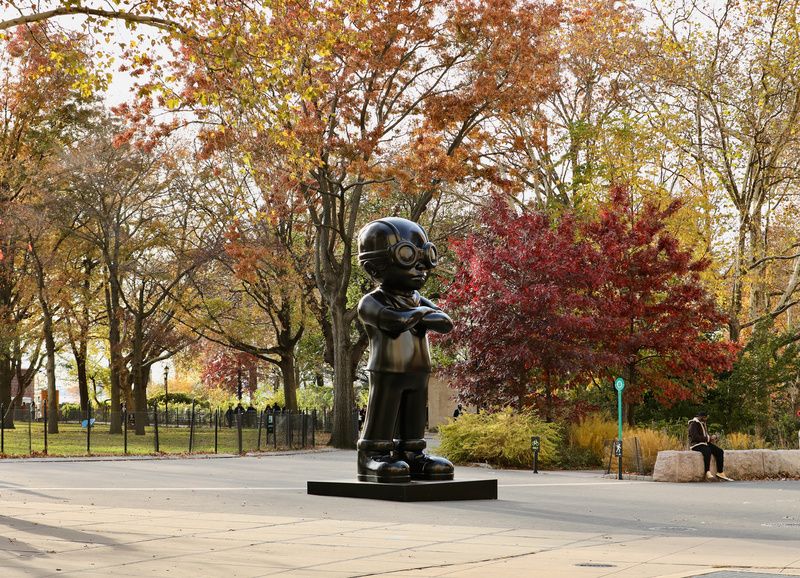
On display at The Battery in Lower Manhattan is artist Hebru Brantley’s 16-foot steel sculpture The Great Debate, depicting Flyboy — a superhero character of color created by Brantley in response to the few characters of color found within the comic book world. Brantley was inspired by the Tuskegee Airmen, the first African-American military aviator pilots who fought in World War II. Flyboy serves as a nod of admiration towards these men, aimed at inspiring future generations to soar above their predicted possibilities, regardless of the challenges standing in their way. Presented in partnership with NYC Parks’ Art in the Parks program, The Great Debate forces its audience to reflect on the meaning of freedom in American society today. The Great Debate will be available for view through November 13, 2022.
For Brantley: “The Great Debate is a piece that is personal and important to me – it features Flyboy in a stance that represents confident optimism. My hope is that The Great Debate at The Battery will serve as a consistent reminder to hold your head high, stand firm in what you believe in, and keep pushing forward with confidence.”

Artist Cecile Chong’s installation EL DORADO – The New Forty Niners pays tribute to the 49% of New York households that speak a language other than English. The installation features 100 colored “guagua” sculptures meant to represent a community of people from around the world, with 49 being painted in gold. Each sculpture varies in height from 8 to 24 inches tall. Chong derived the title for the installation from a story taught to her while growing up in Ecuador, with “El Dorado” meaning “the golden.”
Since 2017, EL DORADO – The New Forty Niners has been displayed in every borough of the city. Currently, it is in its fifth and final iteration at the Dag Hammarskjöld Plaza at 47th Street and 2nd Avenue through August 30, 2022. For this version of the installation, the sculptures have been arranged on 17 colored planks to represent the 17 UN sustainability goals which seek to bring developed and developing countries together in a global partnership to reduce inequality and spur economic growth.

At Prospect Park is Rose DeSiano’s Lenticular Histories, an immersive and interactive monument that aims to celebrate acts of “leisure and activism.” Using reflections, refractions, and nonlinear photo-history, Lenticular Histories takes viewers on a journey through the historical narrative of Prospect Park. To do so, the installation incorporates historical photographs from private collections, public archives, and New York journalists. In addition, the installation uses three objects of optical illusions — stereoscopes, lenticulars, and prisms — to blend reflections, rainbow-colored lights, and history into one singular display.
Presented by the Prospect Park Alliance and curated by Photoville, Lenticular Histories forces its audience to consider the connections between the chaos and harmony of public spaces and how we can learn from the past to change our impending future. Overall, the installation highlights decades of change, while simultaneously displaying how Prospect Park has remained central to the surrounding community over the years. Lenticular Histories will remain on display through spring 2022.

Inside the downtown stairwell between the mezzanine entrance and southbound platform at the 138th St-Grand Concourse Subway Station in the Bronx is Amy Pryor’s mosaic artwork Day Into Night Into Day. Presented by MTA Arts & Design, the four-part mosaic depicts the shifting hours of daylight and darkness over four seasons using a spectrum of colors. Its structure is uniquely based on a twenty-four-hour clock and pie charts. Overlapping the seasonal sunrises and sunsets are charts of stars rarely seen from the Bronx at night. The mosaic’s top left square depicts the winter solstice, the shortest day of the year, while the top right represents the vernal equinox, the first day of spring. In the lower left is the summer solstice, the longest day of the year, and in the lower right is the autumnal equinox, the first day of fall.
As Sandra Bloodworth, Director of MTA Arts & Design stated: “In many ways, Day Into Night Into Day parallels the daily journeys taken by travelers through the station to and from the Mott Haven neighborhood. Amy’s rendering of the rising and setting of the sun highlights the cosmic energy involved in determining the length of our days and nights. The sparkling surfaces of the mosaics bring a contemplative spirit into the station, reminding us that while the evening brings our day to a close, every morning provides us with a fresh start. The artwork captures our imagination and adds a burst of energy and a wave of tranquility to the beginning and conclusion of our travels.”
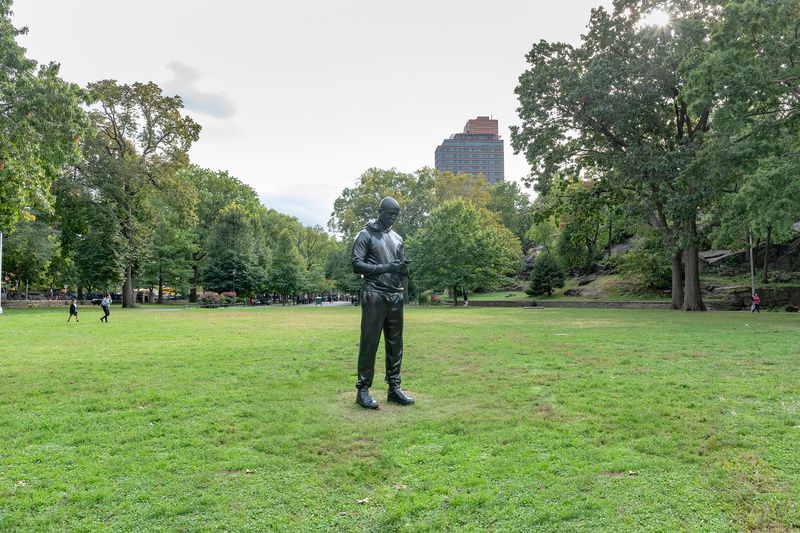
Situated within Marcus Garvey Park is Witness, artist Thomas J. Price’s first solo U.S. museum presentation. Witness features one monumental work titled The Distance Within, a nine-foot bronze sculpture depicting a young Black man looking down at his cellphone. Presented by the Studio Museum in Harlem, Witness celebrates ordinary blackness and asks its audience to consider the function of monuments as defining the familiar. The form of The Distance Within was inspired by Price’s earlier work Network, which was presented in 2013 in the U.K. and drew from the real people who lived and worked in the artist’s neighborhood of Brixton in South London.
In reference to the sculpture, Price stated that he wanted to “interrogate [notions of] presence, movement, and freedom. Whom do these spaces belong to? And what bodies are provided more or less autonomy to move with liberty through public [space]?”
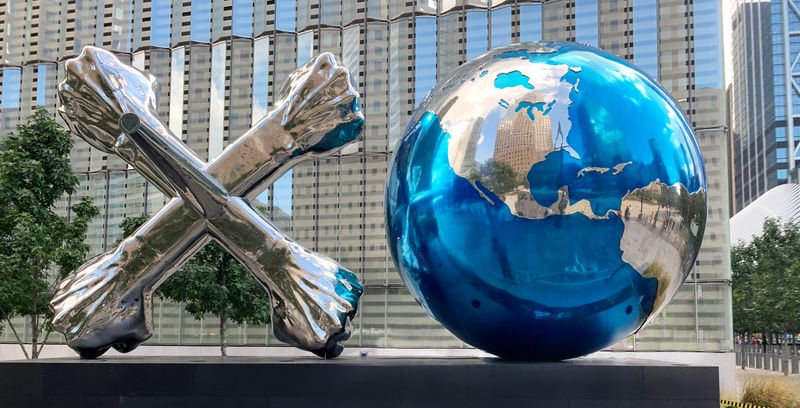
XO World Project consists of two monumental sculptures at the World Trade Center Campus. Designed by artist Daniel Anderson, XO World and XO Play promote messages of inclusivity, hope, and positivity among their viewers. Both sculptures were inspired by the widely played game Jacks. The “X” of XO World is represented by a Jack with crossed arms attached to the spoke — simultaneously being a reference to the word “love” in sign language. On the other hand, the “O” is represented by a globe.
As a whole, XO World is 12 feet tall, 24 feet wide, and made from more than 20,000 pounds of stainless steel. In conjunction, XO Play showcases the unity of all races and the acceptance of children. Its cross-armed jacks symbolize security and safety while a little girl holds a ball reflective of a globe in her hand, symbolizing the impact she stands to have on the world. XO World can be found in front of One World Trade Center on the West Plaza at 285 Fulton Street while XO Play is located inside the Oculus at the World Trade Center. Both XO World and XO Play will remain in New York until they are moved to Paris in 2022. After Paris, the sculptures will be displayed in London, Hong Kong, Moscow, and Dubai.
According to Anderson: “Launching this in the epicenter of the world, New York City, where people come from all different cultures, has created a viral movement of positivity amongst people. It’s working and that is exciting. My inspiration for these sculptures came from children and their open acceptance of others. A child’s mind and heart are free of prejudice regardless of race, gender, or religion, which is something we should all emulate. ‘XO World Project’ will bring people together for many generations to come.”
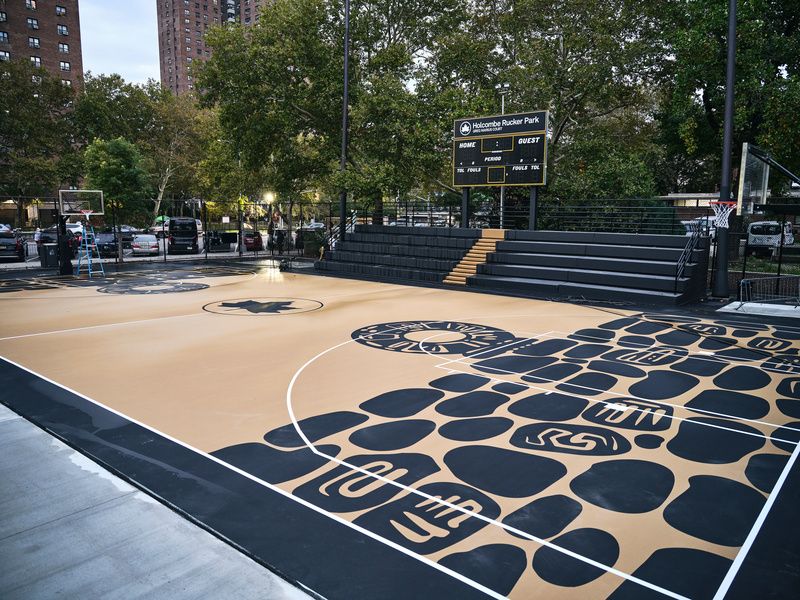
Over the past few months, the National Basketball Player Association (NBPA), local community leaders, and brand partners undertook the task of completely renovating the historic Greg Marius Court at Holcombe Rucker Park in Harlem. As one of the best-known basketball courts in the United States, Greg Marius has become a rite of passage for basketball players growing up in New York City. Renovations included the leveling of the court’s pavement, replacement of the bleachers, backboards, baskets, and scoreboard, the addition of team benches on both sides, and the repainting of the court with a brand new mural known as The Warrior.
Created by Harlem native and renowned rapper A$AP Ferg and curator Set Free Richardson, The Warrior pays homage to the warrior spirit of the Harlem community while embodying the essence of many past, present, and future basketball players.

On display through September 30, 2022, is The Ribbon, a playful interactive platform that invites passersby to connect with Long Island City admirers. The work aims to break down barriers and connect people through moments of open-ended play while also serving as a place for people to stop and engage in fruitful conversations with one another.
The Ribbon has been erected in two public spaces across the Central Court Square area. Each location of The Ribbon features two magenta structures with rotating iridescent panels inscribed with “LIC Love Notes” written by locals. Notes will be continually added to the structure through December 2021 or until all 100 panels are filled. On-site, a QR code is available to contribute a note for the installation. Designers for The Ribbon include Hive Public Space and The Urban Conga, and the project was commissioned by the Long Island City Partnership.

Presented by DIX2, Big Apple is a temporary public art installation in Bella Abzug Park in Hell’s Kitchen. Created by designer Felix Marzell, Big Apple will serve as a new meeting place in the heart of the bustling city, with benches inside allowing visitors to sit within the wooden structure. Whether alone or in a group, Big Apple makes for a perfect spot to come together and create new shared stories and experiences.
On view for through September 2022, Big Apple‘s structure is made of various layers of coated plywood fixed around a central axis with each wooden wedge being designed to create one seat once assembled. The sculpture is presented by the Hudson Yards Hell’s Kitchen Alliance with support from NYC Parks and funding from the Québec Government Office in New York and Amazon NYC.
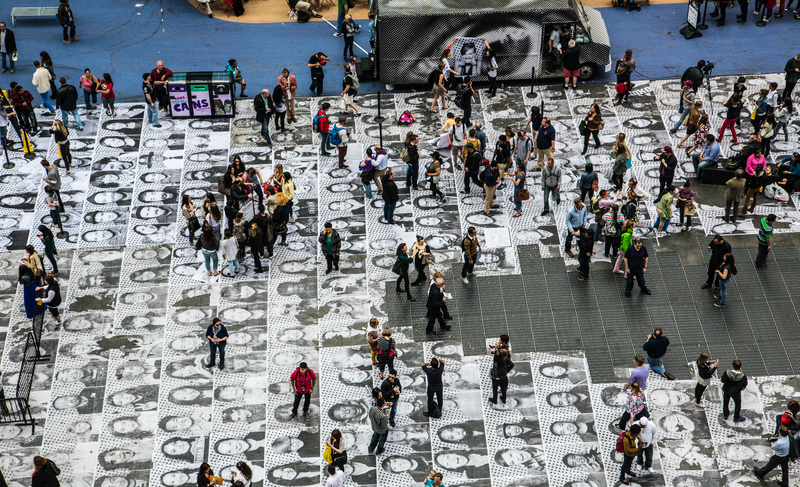
Launching October 3, Inside Out: NY Together is an outdoor gallery — and part of the Inside Out project conceptualized by French artist JR — that celebrates the diverse individuals who make up New York City. Over the preceding five days, passersby through the Garment District will be able to have their photos taken on 40th Street between 8th and 9th Avenues. These black-and-white photos will then be printed in real-time and featured outside the Port Authority — representing the disparate walks of life encompassed by New Yorkers. The gallery is projected to feature portraits of more than 1,200 everyday New Yorkers and measures 40 feet high and 600 feet wide. Inside Out: NY Together will be presented by the Garment District Alliance and the Port Authority of New York and New Jersey.
According to Port Authority Executive Director Rick Cotton: “This outdoor mural will weave inspirational and dynamic public art into the exterior of the bus terminal in cooperation with the local community to dazzle both bus riders and local residents.”

As an additional pop of color, the MTA has unveiled Queens of the Night and No Less Than Everything Comes Together, two permanent mosaic series inside the 1st Avenue and Bedford Avenue L train stations. Created by artist Katherine Bradford, Queens of the Night serves as a tribute to the creatives and essential workers who ride the L train daily. Located in the East Village at the 1st Avenue station, the ethereal figures in Bradford’s work come together to inspire viewers to consider the outward expression of their own interior vivacity. One of the most striking panels from Queens of the Night is “Superhero Responds,” portraying New York’s essential workers in the style of Superman.
Situated in Williamsburg at Bedford Avenue, No Less Than Everything Comes Together features theatrical fairy-like figures under the sun and moon. Created by Marcel Dzama, scenes depicted in No Less Than Everything Comes Together are populated with elegant ballet performers, many of whom are adorned with the black-and-white costumes typically worn by NYC Ballet dancers. Scattered throughout the mosaic series are numerous characters representing infamous Brooklynites including Bugsy Siegel and Captain Jonathan Williams — the founder of Williamsburg.

Inside the new 42nd Street Connector between Times Square and Grand Central is Every One, the first of a three-piece installation by artist Nick Cave. Commissioned by MTA Arts & Design, the installation was created as part of the 42nd Street Shuttle reconstruction and reconfiguration project, costing the city more than $250 million. The figures were made from recomposed source photos of soundsuits taken by James Prinz, which were then interpreted in glass for display on the subway station’s walls.
Every One’s design features a series of figures wearing colorful soundsuits — costumes that camouflage the shape of the wearer. Taking inspiration from African art traditions, ceremonial dresses, and haute-couture fashion, soundsuits are unique in that by covering the entire body, they conceal the wearer’s gender, race, and class, which eliminates audience judgment throughout the performance. Throughout the installation, the figures can be seen jumping and twirling along the wall, with their suits swaying as if moved by the wind. The other two parts of Cave’s installations, Each One and Equal All, will be installed next year at the new shuttle entrance and on the center island platform wall at Grand Central Terminal respectively.

Beginning October 8th, The Trust for Governors Island will present artist Mark Dion’s new installation, The Field Station of the Melancholy Marine Biologist. On long-term view in Building 105 — a historic arsenal structure located within the Governors Island Historic District — The Field Station of the Melancholy Marine Biologist transforms the space into an abandoned research outpost. Scientific objects, instruments, artifacts, and samples featured in the installation were chosen for their connections to Governor Island’s history and the ecology of the New York Harbor and Buttermilk Channel.
For Dion, the installation allows viewers to witness a scene preserved in time, one “where somebody studying the natural world realizes that the future’s not looking so good… that we are going to lose a great amount of the natural wonders that have been here in previous centuries.”

Throughout Lower Manhattan, the public-artspace nonprofit ArtBridge has turned 65 lamp posts into temporary art installations exploring the theme of resiliency. One selection of featured work includes Dances of New York City by Frances Smith. As the name suggests, Smith’s work features breathtaking illustrations of dancers atop colorful backgrounds of key New York City landmarks and iconographies such as the Brooklyn Bridge and subway entrance. With 10 total illustrations, Dances of New York City highlights traditional dance techniques while simultaneously showcasing relatable New York moments such as the “Pizza Soca,” “The Village Cross,” and “Upper West Side Swing.”
Another featured work on display is Geo Grid by painter Michelle Weinberg. Geo Grid expertly utilizes the cylindrical shape of the lamp posts to highlight patterned art. Through the usage of vividly colored geometric shapes, Geo Grid showcases movement as it swirls upward. Art for the lamp posts was selected through a public design competition held this past summer that received more than 100 submissions.

Through May 31, 2022, Brooklyn-based artist Emily Oliveira’s new mural We Are At a Moment That Will Be Remembered as the Beginning of the Great Change, For Who Can Say When a Wall Is Ready To Come Down will be on display at the Lena Horne Bandshell in Prospect Park. Presented by BRIC and Prospect Park Alliance in partnership with NYC Parks’ Art in the Park Program, the 28-foot tall mural depicts a vividly colored natural landscape inhabited by humans and gods partaking in a Promethean sense of rebirth. We Are At a Moment That Will Be Remembered… encourages viewers to use their imagination to envision and enact new ways of being in a post-COVID-era world while simultaneously celebrating the collective action against violence, hate, and separation that has taken place over the last year.
In the view of Jenny Gerow, curator of the mural and Contemporary Art Curator for BRIC, “Emily Oliveira offers a utopian vision of a future that tantalizes but doesn’t overpromise. As the title reflects, who can say when the wall is ready to come down? Still present in the foreground and the background are the remnants of the present, systems of hierarchy and oppression. The artist is masterful in the art of seduction, often achieved in her textile-based work, through the use of shiny and silky textiles and embroidery, but here created through vibrant color and the temptation of touch and care we all have longed for over the past year.”

In Christopher Park, a bust of Black transgender LGBTQ activist Martha P. Johnson was recently erected on August 24th, which would have been her 76th birthday. Today, Johnson is known for her crucial role in the 1969 Stonewall Riots and for co-creating with fellow transgender activist Sylvia Rivera the Street Transvestite Action Revolutionaries (STAR), which sought to provide housing for LGBTQ youth. Later, Johnson served as a staunch activist for survivors during the AIDS crisis before her death in 1992. The city announced in 2019 that it planned to create memorials near the Stonewall Inn for Johnson and Rivera, but these plans never came to fruition. However, rather than continuing to wait for the city to make due on its promise, writer and activist Eli Erlick, sculptor Jesse Pallotta and a number of fellow organizers created a bronze bust of Johnson and installed it inside the park. Additional help in creating the bust was provided by Tourmaline, an artist and filmmaker whose hundreds of archived photos of Johnson gave Pallotta a deeper understanding of her features from every angle.
The bust features Johnson softly smiling with a colorful flower tiara adorning her head. Below the bust is a plaque that honors Johnson’s love of poetry, flowers, space and the color purple. It includes a quote which reads, “History isn’t something you look back at and say it was inevitable. It happens because people make decisions that are sometimes very impulsive and of the moment, but those moments are cumulative realities.” Currently, it is unknown as to how long the bust will remain in the park, but it was specifically designed with the intention of only being up temporarily. It is Erlich and Pallota’s hope that the bust will inspire the city to follow through with creating monuments to Johnson and Rivera and involve Black trans women leaders in New York City in the design process.
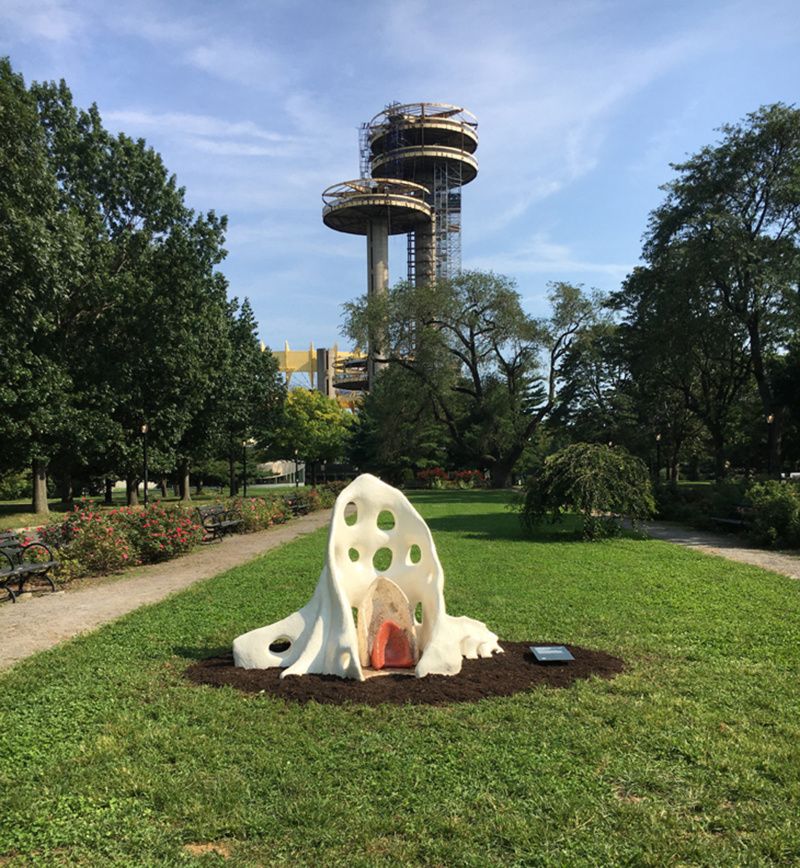
Through August 10, 2022, Endangered Fossils by Judith Modrak will be on display at Flushing Meadows-Corona Park in Queens. Endangered Fossils features a series of sculptures meant to represent an imagined archeological excavation of New York State’s fossil record. Inspiration for the sculptures was drawn from trilobites, brachiopods and crinoids present from the Devonian period 400 million years ago — which today can be recognized for their similarities to modern crabs, clams and starfish. Each sculpture prompts its audience to consider the origins of our ecosystem.
As Modrak writes in her artist statement: “The larger concept was very much about the fossil record in light of disastrous climate change which is causing many species to tragically become extinct, fossils are even “endangered” as certain species may not leave a trace that they ever existed. Endangered Fossils is a homage to our beloved Mother Earth in a critical time requiring immediate attention.”
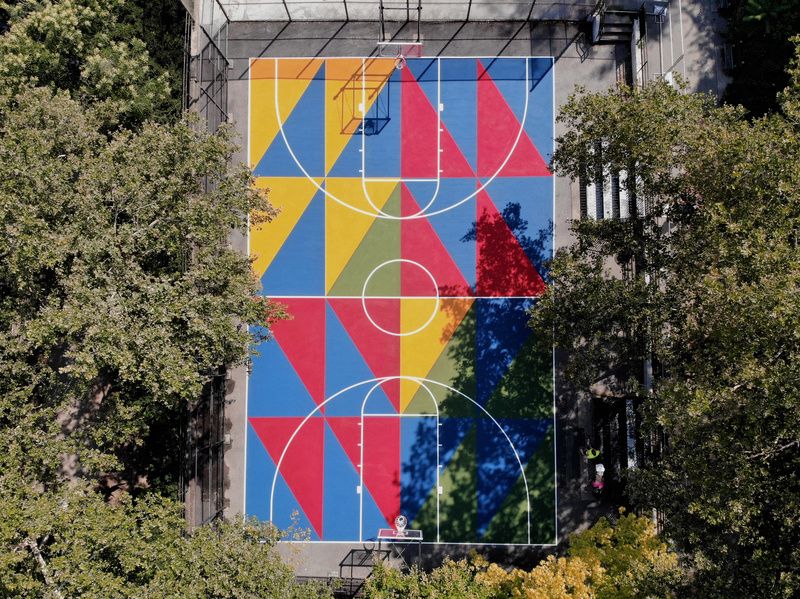
In a basketball court at St. Nicholas Park in Manhattan is Faith Ringgold’s muralWindows of the Wedding #1: Woman. The mural is part of Ringgold’s ongoing Windows of the Wedding series, which began during the 1970s after the artist began experimenting with abstract shapes. Ringgold would go on to receive critical acclaim during the 1980s for her narrative quilts.
Presented by Project Backboard, Windows of the Wedding #1: Woman’s design features a vibrant array of colors painted next to one another in triangle shapes of various sizes. It will be up for view through August 8, 2022.
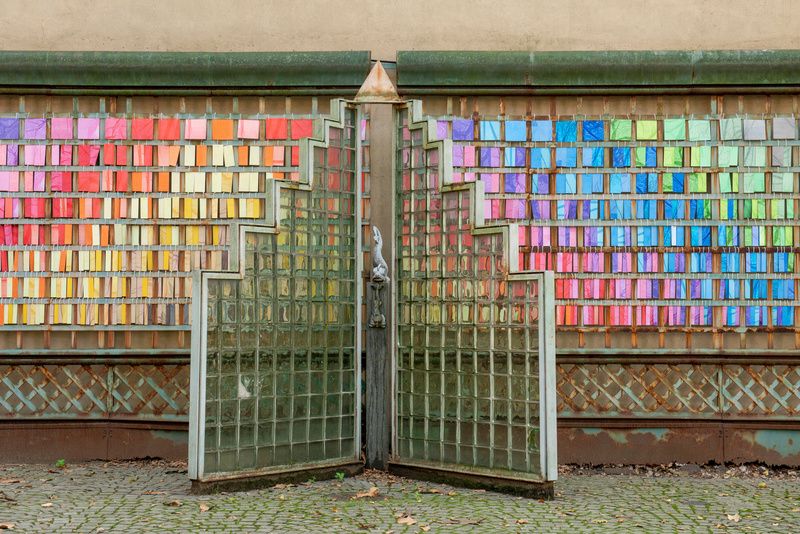
While walking through Harlem Art Park, visitors can marvel at Capucine Bourcart‘s Plastic Fantastic. Measuring 66-feet wide and 7-feet high, Plastic Fantastic’s grand scale illustrates the abundance of single-use plastic and how it has adversely affected our environment and public spaces; New York City residents are estimated to use more than 10 billion single-use plastic bags a year. Plastic Fantastic aims to support the city’s current ban on plastic bags while encouraging residents to take responsibility for their environmental footprint.
To convey this, the installation features plastic bags collected over the last few years by Bourcart from community residents and neighbors. To create Plastic Fantastic, these bags were photographed and printed on 4’ x 8’ sheets of D-bond, a lightweight and durable plastic material. Afterward, the sheets were cut into smaller squares and rectangles to create a color gradient woven into the grid of the park’s ornamental fence. In front of the gradient is a glass block structure which perfectly reflects the colorful background. Funding for the installation was provided by the LMCC, Puffin Foundation, and Friends of Art Park Alliance. Plastic Fantastic will be on display through June 26, 2022.

The Fabulous Plant of Rejuvenation is a 90-foot-tall mural by Baxter St alum Ivan Forde, located on the façade of the newly built Rockaway Hotel in Rockaway Beach, Queens. The mural was curated by Michi Jigarjian, Managing Partner, Creative/Social Impact Officer, with support from 7G Foundation and Facebook Open Arts. Inaugurated on June 18th, 2021, the artwork draws inspiration from the legacy of Rockaway‘s’ Indigenous Lenape people and Forde’s own ancestry — including conversations with his father on the healing powers of water and vegetation. Included in the mural is a depiction of an underwater seascape of poetic sea characters alongside local fish and birds. Its centerpiece is the mythical plant from the ancient Mesopotamian poem The Epic of Gilgamesh. In addition, the mural features a series of healing plants, connected to Forde’s birthplace of Guyana, the Rockaways, and other cultures across the globe.
“My project takes cues from the structures of epic poetry, conversations with ecologists and botanists, and folk traditions our grandmothers and great-grandmothers knew,” Forde said. “These knowledge systems are paramount to the discussions the mural aims to hold space for and align with a symbiotic relationship to nature essential for healing both the human species undergoing a global pandemic and the planet itself.”
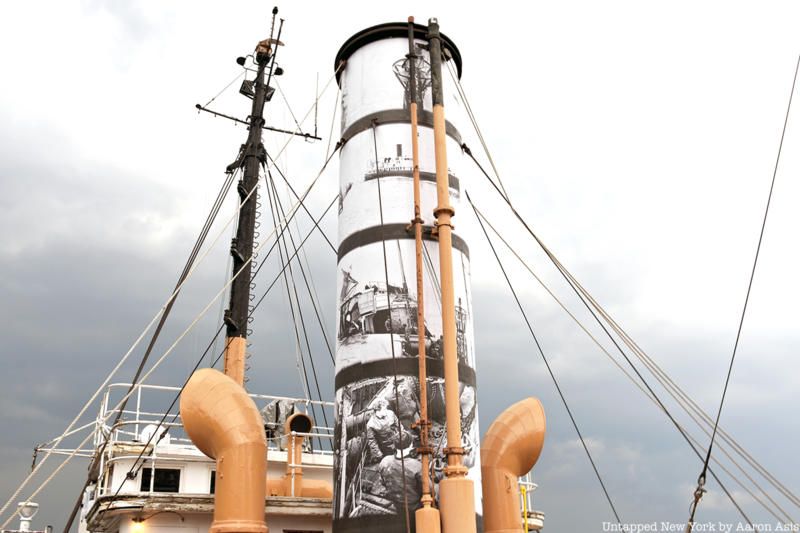
A new mural titled 88 LILAC celebrates the history of the LILAC on Pier 25 in Lower Manhattan. The LILAC is a retired Coast Guard cutter that maintained buoys and carried supplies to lighthouses from 1933-1972. The paper mural, created by Aaron Asis, Untapped New York’s Artist in Residence, displays large-scale historic images wheat-pasted along the ship’s historic stack. When up close, you can listen to a dramatic account of an important moment in LILAC’s history titled “Aids to Navigation,” written by Untapped New York’s Chief Experience Officer Justin Rivers. The public can access the experience via a QR code on Pier 25 while viewing the mural.
As America’s only steam-powered lighthouse tender, revitalization efforts for the LILAC are run by the non-profit LILAC Preservation Project. Its goals are to rehabilitate the ship to operate once again on its original steam engines, promote maritime education, provide a venue for history and art, and offer a community-friendly space for meetings and events. The grand re-opening of the museum ship is slotted for July. In the meantime enjoy a view and a story about its history from the fresh air of Pier 25 in Lower Manhattan.

The Roots of Tuckahoe Marble is an 8-foot-tall public sculpture made of Tuckahoe marble, bronze, and glass by Lara Saget. Historically used for building many of New York’s iconic landmarks like Washington Memorial Arch in Washington Square and Manhattan’s historic New York Marble Cemetery, the story and the supply of Tuckahoe marble have been lost.
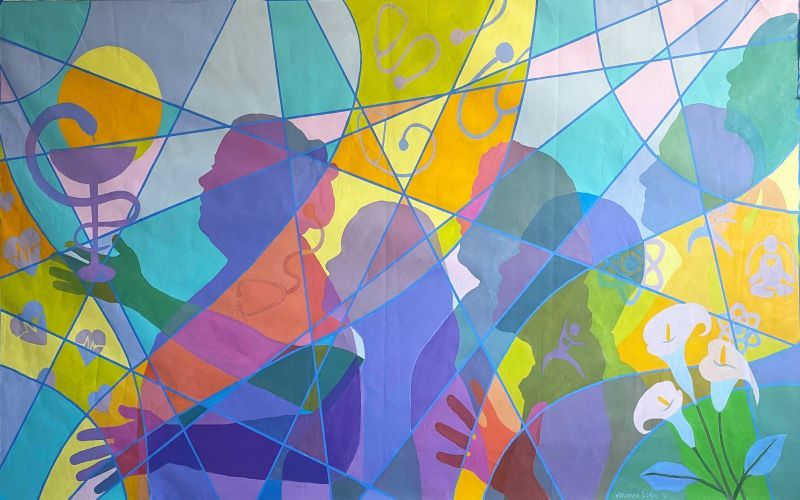
The Community Murals Project of the New York City Health + Hospitals system has unveiled four new murals. Artist Viktoriya Basina created three new murals at Gotham Health/Dyckman Hospital in Inwood celebrating the Dominican community as well as the heroism of the hospital staff. Also unveiled this month is the mural For the People By The People by Daryl Myntia Daniels. Located in the Pediatric waiting room of Gotham Health Sydenham, it depicts notable figures associated with the history of Sydenham and street signs from the Harlem area where the former hospital is located. All the murals were created with community input.
When complete, The Community Murals Project will be the country’s largest public hospital murals program since the Work Progress Administration/Federal Art Project in the 1930s and 1940s. As part of the NYC Health + Hospitals Arts in Medicine program, the project encourages community participation with an artist leader. By the end of summer, there will be 27 murals across the hospital system.
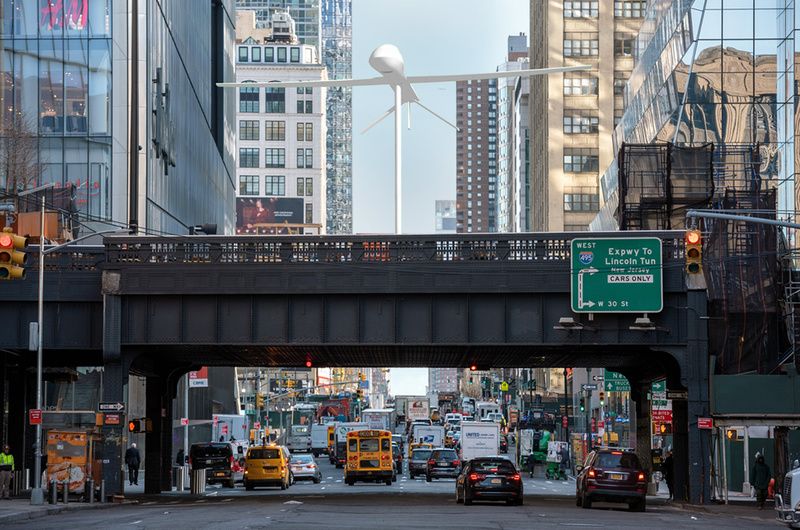
One of several public art installations along The High Line, Sam Durant’s Untitled (drone) is the second High Line Plinth commission. With this work, Durant seeks to make visible the intentionally obscured drone warfare perpetrated by the United States, and to remind the public that drones and surveillance are a tragic and pervasive presence in the daily lives of many living outside—and within—the United States.
This large-scale fiberglass sculpture in the shape of an abstracted drone atop a 25-foot-tall steel pole continues High Line Art’s mission of presenting new, powerful, and thought-provoking artworks that generate and amplify some of today’s most important conversations Untitled (drone) is on view through August 2022.
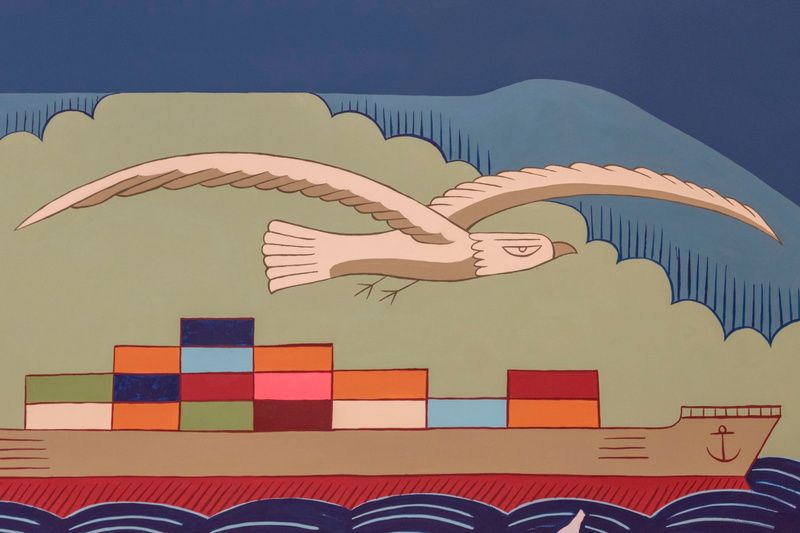
In his large mural work for the Governors Island Ferry Building, artist Duke Riley expands on the ships in a bottle tradition of preciously crafted objects by using a more common bottle of today—single-use plastic containers found floating in oceans worldwide. However, unlike their blown glass and wood-ship-in-a-bottle counterparts, Riley’s painted vignettes appear etched like scrimshaw on the surfaces of items that plague our waterway ecosystems, such as detergent bottles and caulking tubes.
“As a historic center for the arts, Governors Island is proud to welcome yet another celebrated artist to enliven our public spaces,” said Clare Newman, President and CEO of the Trust for Governors Island. “Riley’s work marries the Harbor’s rich history with the Island’s present focus on the pressing issues of the ongoing climate crisis. This intricately beautiful mural looks to both the past and the future, giving visitors the chance to pause and reflect as they enjoy everything the Island has to offer.” The mural will remain on exhibit for the long term.
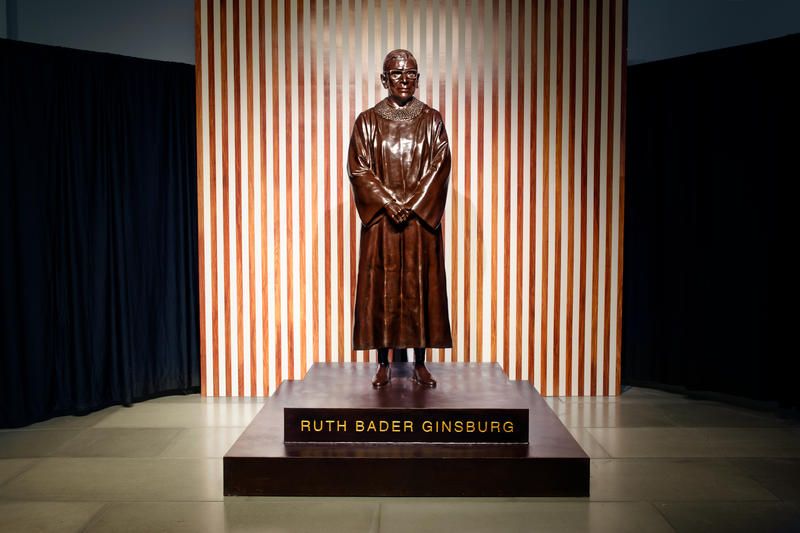
Artist duo Gillie and Marc created this bronze of late U.S. Justice Ruth Bader Ginsburg to commemorate her fight for gender equality and human rights. The statue is one of ten statues of notable women installed in New York City to increase the representation of women in public sculpture from three to ten percent. The statue is on view from noon to 8 p.m. daily in the lobby of City Point in Downtown Brooklyn.
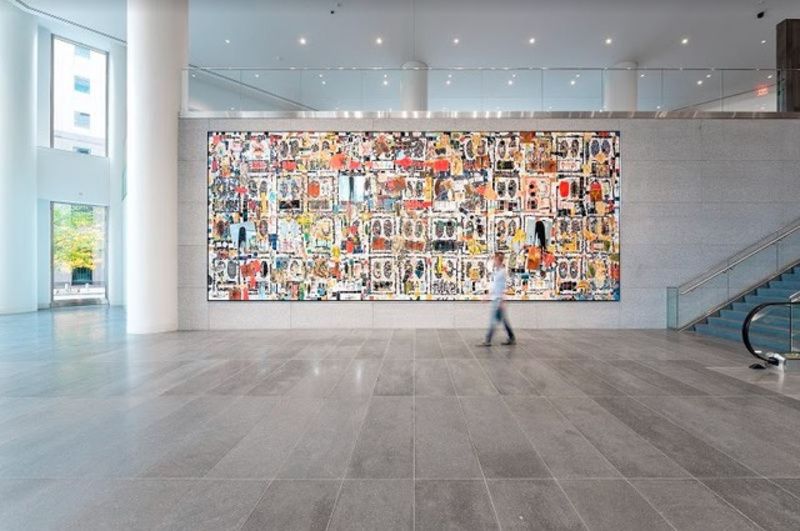
The works of Rashid Johnson employ a wide range of mediums to explore the themes of art history, individual and shared cultural identity, personal narratives, and materiality. His work often includes diverse materials rich with symbolism and personal history.
The mosaic Untitled Broken Crowd is composed of handmade ceramics, wood, brass, oyster shells, spray paint, wax, soap, and mirrors. The soaring piece spans 14 by 33 feet. Located at 200 Liberty Street at Brookfield Place, visitors will be able to contemplate Johnson’s extraordinary piece mounted in the lobby entrance. The glass facade of the building also allows the piece to be highly visible from the surrounding streets.

In July 2021, American contemporary artist Logan Hicks completed Tunnel Vision, the world’s largest stenciled mural. Presented by Taglialatella Galleries, the mural is 19,000 square feet — created with over 100 gallons of paint, 500 cans of spray paint, hundreds of stencils, and dozens of rolls of Gorilla Glue. Located within the East River Plaza on 117th Street in East Harlem, Tunnel Vision includes vivid imagery of lush greenery climbing up the 30-foot walls before merging into the sparkling blue-painted ceiling.
Inspired by Christian Cooper — a Central Park birdwatcher who was victimized in a racially charged confrontation with Amy Cooper in May 2020 — Hicks aimed for Tunnel Vision to recreate the feeling of visiting the Ramble. To accomplish this, dozens of stenciled birds that live within New York State were drawn into the green thicket on the wall. In relation, the mural is accompanied by a custom-designed sound installation featuring a four-hour looping soundtrack, featuring the calls of every bird indigenous to New York. Reflecting on Tunnel Vision, Hicks stated: “This started with a vision of going beyond making just a mural. I wanted to make an environment where people could forget they were in the middle of the city — even if only for a moment.”

For nine months from August 2 to Spring 2022, the Broadway Mall Association will present Jon Isherwood’s Broadway Blooms: Jon Isherwood on Broadway — a series of eight marble sculptures located on the green malls at the center of Broadway from 64th Street to 157th Street. Originally planned for display in 2020, the exhibition’s sculptures were delayed in being transported from Isherwood’s studio in Italy due to the COVID-19 pandemic. Broadway Blooms will mark the Broadway Mall Association’s 13th sculpture show since 2005 as part of their Art on the Malls program.
Each sculpture’s design in Broadway Blooms was inspired by flowers and their diverse cultural meanings — ranging from the imbued spiritual symbolism of the lotus flower to the holiday tradition of poinsettias. Moreover, flowers reflect one’s connection to themselves and their surrounding community; this is reflected in the sculptures’ placements at a series of major intersections along Broadway — which promotes a sense of interconnectedness in spaces that are otherwise impersonal. Carved in Bardiglio Imperiale, Fantastico Arni, and Rosa Portogallo marble, Broadway Blooms offers a beautiful respite from the surrounding urban landscape. At the same time, Broadway Blooms distorts the flowers’ natural appearance, with carved lines contouring the sculptures’ surfaces to create an illusion of expansiveness and promote associations of patterning, layering, and veiled imagery.
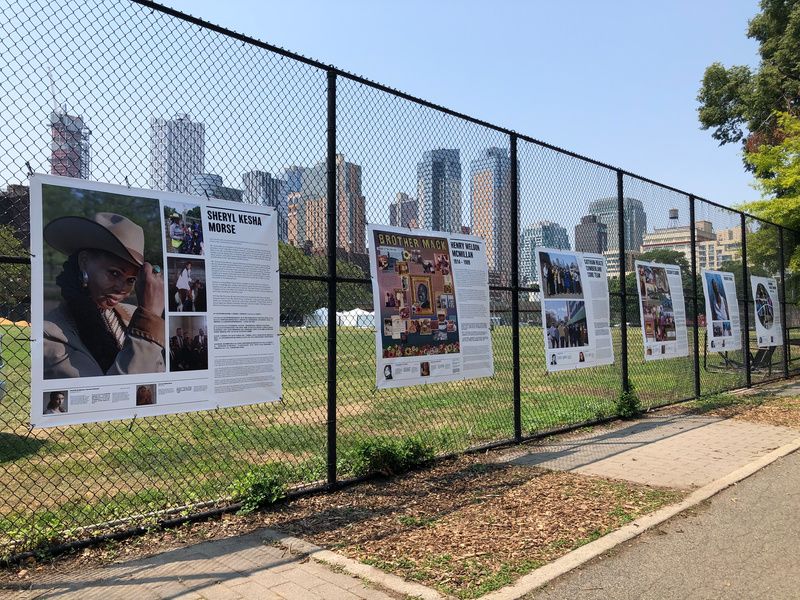
Community Heroes is a community-based public art project celebrating people whose generosity is felt throughout their community. Co-founded in 2016 by Jasmin Chang and Zac Martin in their neighborhoods of Fort Greene and Gowanus, the project aims to highlight the achievements of everyday citizens. Special attention is paid to selecting persons of color from often overlooked communities who have had a faithful and stable long-term presence in their neighborhoods through volunteering, advocacy, mentorship and creativity. Organized and produced by Photoville and Trellis, Community Heroes receives additional support from Partnerships for Parks and PhotoWings. Past projects have included Arts to End Violence, a showcase of young artists committed to anti-violence work, and It’s Happening, a celebration of 50 years of the Arts in the Park program.
To produce their work, Community Heroes partners with communities across NYC to nominate heroes. Afterward, these individuals are paired with local artists to make their portraits and youth writers to interview them. The results of this are then displayed as an art exhibition in a local public space. This summer, Community Heroes will have two projects on display. The first is located at Fort Greene Park along the Brooklyn Hospital fence and in Commodore Barry Park along the football field. One featured hero will be Kesha S. Morse, who became the first female member, officer, and President of the New York City Federation of Black Cowboys. This iteration of Community Heroes will run through June 2022. The second project will be open for view from August 10 to July 2022 in Bed-Stuy at St. Andrews Playground along Herkimer Street and Kingston Avenue.

Through June 30, 2022, Susan Stair’s public art exhibition Ascending the Mountain will be on display at Marcus Garvey Park. Drawing inspiration from the underground network used by trees to communicate and share resources, Stair’s exhibit tells a story of remarkable natural growth. What began as a few trees planted during the early 20th century on a mountain of Manhattan Schist has since grown into a sprawling urban forest — its roots pushing down through the land’s rocky outcropping. Today, the naturally seeded forest provides shade, moisture and oxygen while attracting birds and small animals to the surrounding neighborhoods of Harlem.
Ascending the Mountain was installed in three distinct sections along the staircase leading up to the overlook terraces known as the Acropolis and the Harlem Fire Watchtower. The installation provides visitors with eye-level views of the adjacent forest area so that viewers can more effectively make direct connections between the exhibit and its surrounding natural environment. The first section, Roots n Rocks — located near the base of the stairs on the east side of the mountain — focuses on the roots of the now mature trees and how they have moved underground to gather nutrients and resources. One level up is the second section Growing Powerhouse, which illustrates the trees’ ability to bring gallons of water and minerals up the side of the mountain through their trunks. Just below the upper level of the park is the final section, Tree Canopy, which encourages viewers to connect the artwork with the real-life treetops.
Next, check out our upcoming tours to explore more of New York City!
Subscribe to our newsletter